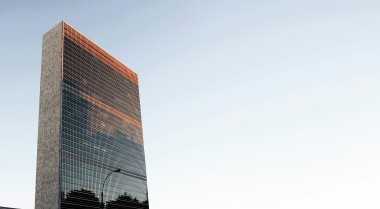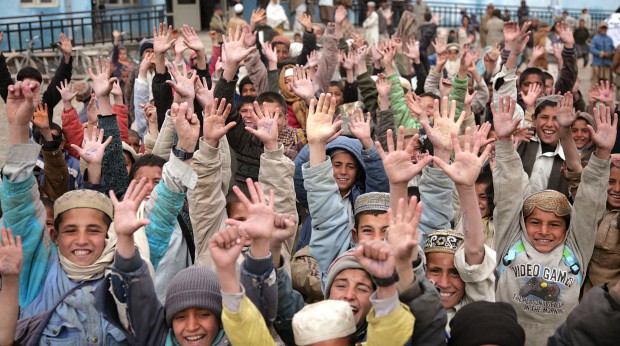8 Key Takeaways for Local Peacebuilders from the Informal Phase of the 2025 Peacebuilding Architecture Review Ahead of the Formal Phase
The UN Peacebuilding Architecture (PBA) undergoes an assessment every five years to evaluate its effectiveness. What makes the 2025 Peacebuilding Architecture Review (2025 PBAR) particularly interesting for local peacebuilders is its emphasis on the impact of the UN peacebuilding work at the field level. For the first time, this question shifts the conversation from talking about how can the UN work better to whether the UN peacebuilding action has a real impact on people’s lives.
Finding an answer to this question is not easy. This is largely because the UN Peacebuilding Architecture is composed of entities that local peacebuilders do not know much about - the Peacebuilding Commission (PBC), Peacebuilding Fund (PBF) and Peacebuilding Support Office (PBSO). Apart from a few PBF in-country Secretariats, these entities are New York-based. In the absence of clear peacebuilding strategies within the UN country teams and regional offices, even UN field presences appear to be ‘too far away’ for many. The shift in the 2025 PBAR focus could be an opportunity for local peacebuilders and policymakers to jointly reform the multilateral system to be more relevant at the field level.
This article summarises the major inputs into the 2025 PBAR. It aims to outline eight priorities that local peacebuilders can continue raising with Member States, including their national governments, to ensure that global policy truly reflects the needs of communities.
What are we now? The Launch of the 2025 PBAR Formal Phase
The process of seizing the opportunity to reform the system is already underway. In December 2024, the informal phase of the 2025 PBAR ended, offering insights from diverse stakeholders on the ways to strengthen the UN peacebuilding architecture. Two main documents emerged during this phase: the letter from independent eminent persons (the IEP Letter) and the Secretary-General’s report on peacebuilding and sustaining peace (the SG Report). They are more likely to be read by all Member States, as they are official UN documents.
In 2025, Member States will use the insights from the informal phase to negotiate an outcome document (a resolution) through a formal process of negotiations among Member States. This resolution will identify how the UN Peacebuilding Architecture will advance impactful peacebuilding and sustaining peace at the field level.
How can Local Peacebuilders use the Insights from the Informal Phase of the 2025 PBAR?
We propose eight main insights that could inform the continuous engagement of local peacebuilders in the 2025 PBAR.
First, the IEP Letter highlights that sustaining peace requires ‘truly national and inclusive ownership’ (A/79/634-S/2024/869, p. 3). This is an important point for follow-up because the responsibilities of Member States in peacebuilding and sustaining peace have never been clearly articulated. However, the IEP Letter does not help such articulation. The outcome document of the 2025 PBAR should clarify national responsibilities, creating a space for assessment of how Member States perform on sustaining peace. If Member States regularly report on their SDG and human rights commitments, there is no reason why they cannot articulate and report on commitments in peacebuilding and sustaining peace. Inclusive national ownership could include: 1) identifying a government entity responsible for peacebuilding and sustaining peace, 2) establishing clear modalities of civil society engagement in decision-making on peacebuilding and sustaining peace, 3) developing a national prevention or peacebuilding strategy, 4) ensuring domestic mobilisation of resources for peacebuilding.
Second, experts and policymakers unanimously agree that financing for peacebuilding needs to be improved. The resources for peacebuilding are rapidly shrinking, as many donors are losing their peacebuilding budgets. Even more concerning is the fact that the informal phase of the 2025 PBAR barely considered the principles of quality financing and reflected on how money is spent. The IEP Letter refers to quality financing (A/79/634-S/2024/869, p. 5) but does not unpack it. The SG Report recommends ‘longer-term and flexible funding mechanisms to strengthen the capacities of local communities to support national peacebuilding efforts’ (A/79/552-S/2024/767, para. 34). While these are important points, Member States should progress on their quality financing commitments made in 2022, including participatory grantmaking, good intermediary models and donor coordination. The 2025 PBAR can mandate a review of the implementation of the 2022 resolution. Local peacebuilders should also encourage Member States to commit to adequate, predictable, sustained and accessible (or quality) financing for peacebuilding and encourage testing innovative and participatory funding models.
Third, amidst the global crisis of multilateralism, the informal phase of the 2025 PBAR did not shed much light on the role of the UN in the global peacebuilding architecture. Peacebuilding is not solely the responsibility of the UN. Regional organisations, local peacebuilders, national governments, and community members all have a role to play. The UN should focus on areas where it adds value. Member States and local peacebuilders agree that the UN’s strength lies in offering technical advice, convening diverse stakeholders and providing political accompaniment. The UN should not compete with local peacebuilders and regional organisations for funding. Instead, its role should be to transfer peacebuilding responsibilities to regional, national and local actors who have a vested interest and expertise in building peace within their communities.
Fourth, both the IEP Letter and SG Report highlight that the UN Peacebuilding Architecture extends beyond the PBC, PBF and PBSO (A/79/634-S/2024/869, p.3, A/79/552-S/2024/767, para. 41). All UN agencies, funds and programmes, as well as peacekeeping missions and special political missions, should contribute to the UN mandate to build and sustain peace. The UN field presences should offer strong and empowered UN peacebuilding leadership, a clear peacebuilding strategy that enables in-country and field level-UNHQ coordination within the UN System, adequate peacebuilding capacities (i.e., peace and development or peacebuilding advisors funded out of the core budget), and institutionalised modalities for civil society engagement. The UN field presences should follow up on the UN System-Wide Community Engagement Guidelines to 1) map out relevant partners, including existing community structures and networks that are representative of broader constituencies and 2) identify joint activities and regular spaces for meaningful civil society contributions, such as the Common Country Analyses (CCA) and Cooperation Framework monitoring. At the global level, Member States should sustain and strengthen the CS-UN Dialogue on Peacebuilding and establish a clear mechanism for diverse and independent civil society engagement in the PBC work.
Fifth, the international community should reflect on what peacebuilding impact actually means. Local peacebuilders emphasise that peace cannot be defined by outsiders and raise an important question for the 2025 PBAR formal phase: who defines the results of peacebuilding efforts, and the value of those results? Such an inquiry marks a shift from using ‘localisation’ as a buzzword towards unpacking what localisation means in practice. Local peacebuilders need to continuously remind Member States that localisation requires 1) putting local needs ahead of political interests and 2) building on the work local peacebuilders are already doing. For the 2025 PBAR, this means determining performance indicators for the UN leadership at all levels to assess their action towards localisation and providing funding that is rooted in priorities determined at the local level.
Sixth, the Impact Hub should lead knowledge management in peacebuilding. Launched in December 2023, the Hub aims to advance a more holistic, evidence-based approach to peacebuilding and make the impact of peacebuilding clearer. The Hub should adopt an inclusive and comprehensive approach to collecting evidence of peacebuilding impact and determining what works. It should not become a platform for documenting the UN’s own impact to support its fundraising efforts. Instead, it should guide Member States in supporting the most impactful peacebuilding actions. An annual peacebuilding research and knowledge conference, recommended by NUPI, could be held during the UN peacebuilding week suggested in the SG Report (A/79/552-S/2024/767, para. 67). This conference could regularly bring together diverse knowledge holders, including local peacebuilders, to develop ‘a more compelling and impactful narrative around peacebuilding’ (A/79/634-S/2024/869, p. 4). While this process is currently remote from the immediate needs of local peacebuilders, this can serve as an avenue to bring global policy discussions and local peacebuilding action closer together.
Seventh, to achieve ‘a more strategic PBC’ called for by Member States in the Pact for the Future (Action 44), the PBC Secretariat must be strengthened. It will give the PBC an opportunity to assess where the PBC has achieved and can achieve the most impact, including at the field level. Recommendations for the PBC to become a knowledge holder on peacebuilding for the UN System should be put on hold as it is unclear to what extent the PBC would be able to meaningfully use this knowledge. Many peacebuilders, as well as Member States, suggest that the value proposition of the PBC is unclear. A strengthened PBC Secretariat can develop a more focused outreach strategy and create ways to bring more relevant stakeholders, including local peacebuilders, into the PBC work.
Eight, the Pact for the Future invites all Member States to adopt national prevention strategies on a voluntary basis (Action 18). At GPPAC, we often hear from local peacebuilders ‘what is this all about?’ This question indicates that global processes often do not include local peacebuilders in the development of concepts generating too many conversations at the UNHQ. Early warning systems and local infrastructures for peace are mechanisms better understood by local actors. Yet, global policy discussions do not refer to them in resolutions on peacebuilding and sustaining peace. Local peacebuilders can see a national prevention strategy as an approach that would bring together diverse efforts to build peace as they engage with their governments around the 2025 PBAR. However, even assuming that Member States would commit to the development of such strategies, can the UN provide a comprehensive package of services to help Member States in developing such strategies? The lack of coordination among various UN entities on prevention is a well-established fact that the informal phase of the 2025PBAR left out. The IEP Letter attempts to address this challenge by asking the UN to provide coordinated support through the RC Offices (A/79/634-S/2024/869, p. 5). However, it is unclear from where the RC Office will obtain support to do so. The SG Report says that the provision of technical support to Member States continues to be the priority for the UN (A/79/552-S/2024/767, para. 30), but it does not provide a concrete proposition regarding how this support will be provided. Local peacebuilders can ask their Member States to call upon the SG to develop 'a comprehensive conflict prevention strategy' and devise a coordination mechanism that will bring the UN prevention expertise together.
Why Should Local Peacebuilders Engage in the Formal Phase of the 2025 PBAR?
Some of the points raised above may feel daunting or too removed from the realities of local peacebuilders, and we acknowledge that. However, global policy, when informed by local actors, can make a difference for local peacebuilders. A clear example of this is the recognition of local peacebuilders as critical stakeholders in peacebuilding and sustaining peace resolutions which has incentivised the donor community to invest in local peacebuilding (A/RES/70/262-S/RES/2282, OP4(d); A/RES/75/201-S/RES/2558, OP1).
Yes, progress in global policy is slow. Yes, it often falls on local peacebuilders to move the process that sometimes seems too heavy to budge. But the time is now for locals to speak up to ensure that Member States do not create more mechanisms and functions that complicate the UN Peacebuilding Architecture into an even more complicated maze. Instead, they must work to transform the UN Peacebuilding Architecture into a system that delivers meaningful change for them.


